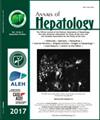当代美国成年人的睡眠模式和失调与代谢功能障碍相关的脂肪肝和肝纤维化的关系
IF 3.7
3区 医学
Q2 GASTROENTEROLOGY & HEPATOLOGY
引用次数: 0
摘要
睡眠对美国成年人代谢功能障碍相关性脂肪肝(MASLD)的影响仍不清楚。本研究旨在全面探讨睡眠模式和失调与 MASLD 和肝纤维化的关系。这项横断面研究纳入了2017-2020年全国健康与营养调查的成年参与者。我们采用多变量调整回归分析来研究睡眠与MASLD和肝纤维化的关系。我们还使用限制性三次样条、中介分析、分层分析和多重敏感性分析进一步探讨了这些关联。我们共招募了 5368 名参与者。某些睡眠障碍、睡眠持续时间、高睡眠负债和特定睡眠-觉醒时间与 MASLD 相关。工作日晚睡是MASLD和肝纤维化的共同风险因素。工作日和空闲日的睡眠时间短有利于MASLD,而每周平均睡眠时间长则可预防MASLD。工作日、空闲日和每周平均最佳睡眠时间分别为7.5小时、8小时和7.78小时。中介分析表明,空腹血糖和高密度脂蛋白胆固醇间接中介了睡眠时间与MASLD之间的关系,而分层分析表明,性别影响了两者之间的关系,而且只有女性和特定年龄组的人群才观察到这种相关性。睡眠时间的长短会独立地影响 MASLD,但只有女性和特定年龄组的人才会受到影响。此外,工作日晚睡是MASLD和肝纤维化的共同风险因素。这些结果表明,应针对睡眠行为预防MASLD,并制定针对不同年龄和性别的策略。本文章由计算机程序翻译,如有差异,请以英文原文为准。
Association of sleep patterns and disorders with metabolic dysfunction-associated steatotic liver disease and liver fibrosis in contemporary American adults
Introduction and Objectives
The impact of sleep on metabolic dysfunction-associated steatotic liver disease (MASLD) in American adults remains unclear. This study aimed to address the relationship of sleep patterns and disorders with MASLD and liver fibrosis comprehensively.
Materials and Methods
This cross-sectional study included adult participants from the National Health and Nutrition Examination Survey 2017-2020. Multivariate adjusted regression analysis were used to examine the association of sleep with MASLD and liver fibrosis. We further addressed these associations using restricted cubic splines, mediation analysis, stratified analysis and multiple sensitivity analysis.
Results
We enrolled 5368 participants. Certain sleep disorders, sleep duration, high sleep debt and specific sleep-wake time were associated with MASLD. Late workday sleep was a shared risk factor for MASLD and liver fibrosis. Short sleep on workdays and free days favored MASLD, whereas average weekly long sleep protected against MASLD. Workday, free day and average weekly optimal sleep duration was 7.5 h, 8 h and 7.78 h, respectively. Mediation analysis suggested that fasting glucose and high-density lipoprotein cholesterol indirectly mediated the relationship between sleep duration and MASLD, whereas stratified analysis showed that sex influenced the relationship, and that the correlation was only observed in women and specific age groups.
Conclusions
Sleep duration independently affected MASLD but only in women and specific age groups. Moreover, late sleep on workdays was a shared risk factor for MASLD and liver fibrosis. These results suggest targeting sleep behaviors for MASLD prevention and developing age- and sex-specific strategies.
求助全文
通过发布文献求助,成功后即可免费获取论文全文。
去求助
来源期刊

Annals of hepatology
医学-胃肠肝病学
CiteScore
7.90
自引率
2.60%
发文量
183
审稿时长
4-8 weeks
期刊介绍:
Annals of Hepatology publishes original research on the biology and diseases of the liver in both humans and experimental models. Contributions may be submitted as regular articles. The journal also publishes concise reviews of both basic and clinical topics.
 求助内容:
求助内容: 应助结果提醒方式:
应助结果提醒方式:


